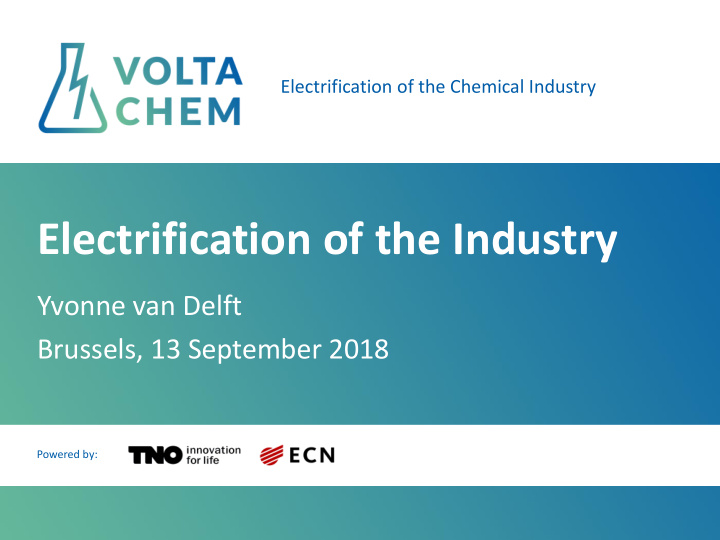



Electrification of the Chemical Industry Electrification of the Industry Yvonne van Delft Brussels, 13 September 2018 Powered by:
0.9 GW (2016) 4.5 GW (2023) 250? GW (2050) Powered by: TNO & ECN
From fossil feedstock to renewable electricity as primary energy source Powered by: TNO & ECN 22-10-2018 3
Powered by: TNO & ECN 22-10-2018 4
National energy use Fertilizers Share of 3167 PJ = 880 TWh final use 5%1% Plastics Chemistry 10% Refineries 27% Industry other 10% Oil and gas Chemicals Transport 5% Housholds 14% Electricity production 10% Services 2% 16% Agriculture Waste and water Fuels Focus on value chains: Fuels, Plastics & Fertilizers Powered by: TNO & ECN 22-10-2018 5
Powered by: TNO & ECN 22-10-2018 6
• Flexibility – Response time - short - Short-term option – Operating hours – relatively low - Power-2-Heat – Allowable investment costs – low - Power-2-Hydrogen – Technologies at high TRL • Electrification – Response time – less an issue - Mid/Long-term option – Operating hours – high (base load) - Power-2-Heat - Power-2-Hydrogen – Allowable investment costs – higher - Power-2-Chemicals – Technologies at mid/low TRL Powered by: TNO & ECN 22-10-2018 7
Up to 60 MW in 1 unit • Flexibility – Direct electrical heating – Heat/cold storage – Multifunctional/reversible equipment • Electrification – (Direct electrical heating) – Mechanical vapour recompression – Electrical heat pumps Powered by: TNO & ECN 22-10-2018 8
Power-to-liquids (Sunfire) Power-2-Gas (Hydrogenics) Power-to-Methanol (Bayer) Efficient Chlorine electrolysis (Wacker) Powered by: TNO & ECN 22-10-2018 9
Electrification of the Chemical Industry Powered by:
Process Business case is positive at all price scenario’s. • Mechanical energy is used to upgrade low quality steam to Base case cumulative NPV is positive after 3 year. be used in industrial processes Key parameters • COP of 6 with temperature lift of 60 ⁰C from waste steam at 120 ⁰C Scenarios based on the report “ Scenarios for the Dutch • 10 MW capacity electricity supply system: A report prepared for the Dutch • Base load operations (96% on in base case) Ministry of Economic Affairs”, Frontier Economics, • Lifetime of 80,000 hours with yearly extension maintenance Payback time 3 years September 2015. Base case scenario cash flow Results for various scenarios are for all scenarios positive Powered by: TNO & ECN 22-10-2018 11
Process Business as usual (base case) does not result in a • Direct electrochemical reduction of CO 2 to CO positive business case. The capital investment is • H 2 produced simultaneously from reduction of water the most important factor and can be decreased Key parameters by increases in current density and system • Based on laboratory system utilising copper-based lifetime. electrodes (current density of 6 mA/cm 2 @ 90% efficiency) An increase in current density by a factor of 2.54 • 0.7 MW capacity (1 Mton CO per year) gives a breakeven NPV at year 20. • Base load operation • Lifetime of 80,000 hours with yearly extension maintenance Decrease CAPEX by further Base case scenario based on Frontier Economics, 2015 . development Results of sensitivity analysis Base case scenario cash flow Powered by: TNO & ECN 22-10-2018 12
Electrification of the Chemical Industry Powered by: 22-10-2018 13
• Assumptions: – Current heat consumption in chemical industry 243 PJ (43% > 200 ◦ C). – Full implementation of Heat Pumps & residual steam upgrading by Mechanical Vapour recompression in industry. – Giving 50% savings for high temperature steam. • Result: – 15-20% energy savings. – 2 TWh / year electricity consumption. – 6 Mt / year CO2 reduction. – 1 GW peak electricity use. – 4% of renewable capacity in 2030. Powered by: TNO & ECN 22-10-2018 14
• Assumptions: – Current hydrogen consumption in Netherlands 63 PJ (requiring 81 PJ of natural gas as feedstock). – Full replacement of SMR by electrolyzers. • Result: – 4.1 Mt / year CO2 reduction. – 26 TWh / year electricity consumption. – 6 GW electricity use at 50% load. – 20% renewable capacity in 2030. Powered by: TNO & ECN 22-10-2018 15
Full electrification needs 250 TWh / year Full electrification decreases CO 2 22 Mt / year CO2 as feedstock with 3 t CO 2 / t olefins 23 Mt/year CO2 use Powered by: TNO & ECN 22-10-2018 16
Source: FD, 22-3-2016 Source: FD, 15-4-2016 2016: 0.9 GW = 4 TWh 2023: 4.5 GW = 18 TWh 2050: 250 GW = 1000 TWh Powered by: TNO & ECN 22-10-2018 17
• The future is unpredictible but industry will play an important role – The (chemical) industry uses 44% of all energy in The Netherlands – Future determined by step-changes in technology development , by the societal and market conditions and by regulations – Keep options open and invest at the right time with the right business driver. • Short-term electrification potential in flexibility – Business cases driven by flexibility & incentives – Power-2-Heat & Power-2-Hydrogen – Upward potential: • 10 Mt/year CO 2 reduction. • 28 TWh/year electricity use. • Long-term electrification potential in products – Business cases driven by product value & CO 2 regulations. – Power-2-Chemicals – Upward potential: • 45 Mt/year CO 2 reduction. • 250 TWh/year electricity use. Powered by: TNO & ECN 22-10-2018 18
Yvonne van Delft Innovation Manager vandelft@ecn.nl Martijn de Graaff Business development martijn.degraaff@tno.nl www.voltachem.com Powered by: TNO & ECN 22-10-2018 19
Recommend
More recommend